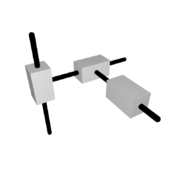
Cartesian coordinate robot
Encyclopedia

Industrial robot
An industrial robot is defined by ISO as an automatically controlled, reprogrammable, multipurpose manipulator programmable in three or more axes...
whose three principal axes of control are linear (i.e. they move in a straight line rather than rotate) and are at right angle
Right angle
In geometry and trigonometry, a right angle is an angle that bisects the angle formed by two halves of a straight line. More precisely, if a ray is placed so that its endpoint is on a line and the adjacent angles are equal, then they are right angles...
s to each other. Among other advantages, this mechanical arrangement simplifies the Robot control
Robot control
-See also:* Control theory* Mobile robot navigation* Robot kinematics* Simultaneous localization and mapping* Robot locomotion* Motion planning* Robot learning* Vision Based Robot Control...
arm solution
Arm solution
In applied mathematics as used in the engineering field of robotics, an arm solution is a solution of equations that allow the calculation of the precise design parameters of a robot's arms in such a way as to enable it to make certain movements....
. Cartesian coordinate robots with the horizontal member supported at both ends are sometimes called Gantry robots. They are often quite large.
A popular application for this type of robot is a computer numerical control machine (CNC machine). The simplest application is used in milling and drawing machines where a pen or router translates across an x-y plane while a tool is raised and lowered onto a surface to create a precise design.

